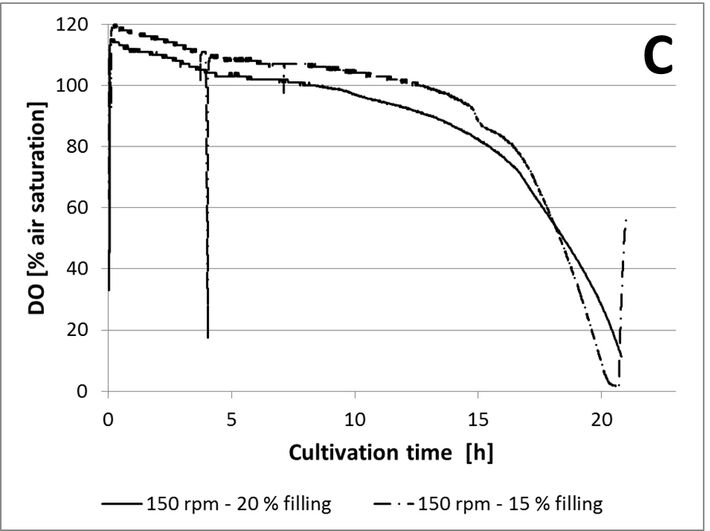Watch tutorials, webinars and informative videos about PreSens optical sensor systems.
The Application of the SFR Shake Flask Reader in Teaching at the Esslingen University of Applied Sciences
Non-invasive Measurements of Dissolved Oxygen and pH in Shake Flasks within the Framework of Practical Courses and Student Projects

A. Komitakis, K. Schatz, M. Hoß, R. Biener
Department Biotechnology, Esslingen University of Applied Sciences, Germany
Dissolved oxygen (DO) and pH are key parameters for microbial fermentations and cell cultures. The importance of DO and pH for bioprocesses as well as methods for their measurement are taught to students in our bachelor (B. Sc. Biotechnology) and master program (M. Eng. Bioprocess Engineering). In measurement and control lectures the students learn, amongst others, measurement principles and applications of Clark-type and optical oxygen sensors and pH sensors. In lab courses and project works the students use such sensors to monitor and control the respective parameters in bioreactors. However, in precultures or small scale cultivations, which are mainly performed in shake flasks, DO and pH could not be monitored online so far. While samples can be drawn for offline pH measurement, there was no practical way to measure the DO in shake flasks. Thus, cultures often were oxygen limited leading to reduced productivity, reduced growth or even cell death.
By purchasing the PreSens SFR Shake Flask Reader we are now able to monitor DO even in shake flasks with sizes between 100 and 1000 mL. Since up to nine flasks can be monitored simultaneously many experiments can be performed in parallel. In the master lab course "procaryotic bioprocesses" the SFR is used for the optimization of precultures for Corynebacterium glutamicum. The students learn the effects of different factors influencing cell growth by varying for example flask geometry, filling volume and shaking frequency. Furthermore, the impact of different flask caps and antifoam agents on cell growth were tested. The SFR is also applied within the framework of student project works, where students are supposed to investigate a scientific question on their own, e. g. the kLa quantification in shake flasks under different conditions, the optimization of growth media or the production of recombinant proteins.
Materials & Methods
For the optimization of the preculture of a pipecolic acid producing C. glutamicum strain students investigated the influence of the filling volume (15 % and 20 %), the shaking frequency (130 rpm and 150 rpm), the flask cap (aluminum caps and silicone sponge filters) and the addition of an antifoam agent. Cultivations were performed with CgXII minimal medium containing 20 g/L glucose in 500 mL Schott Duran glass shake flasks with four baffles (see Fig. 2) at 30 °C. DO in
% air saturation was measured with the SFR and integrated autoclavable sensor spots at an interval of 1 min. Additionally the cell dry weight and the glucose concentration were determined after 22 hours of cultivation. Each approach was done in duplicate. No statistical analysis was done for this experiment but the measured curves did not seem to show significant variances. For reasons of simplification the DO values of only one flask of each double determination are displayed in the following.
Results of a Student Project on the Optimization of Precultures
For the first test the filling volume was kept constant at 20 % and no antifoam agent was added. Shake flasks were incubated at 150 and 130 rpm and each with both aluminum and silicone caps. As shown in figure 3A shaking at 150 rpm resulted in higher oxygen transfer rate from the headspace into the medium, than shaking at 130 rpm. Whereas cultures with aluminum caps were already oxygen limited after 12 hours, cultures with silicone caps lasted up to 21 hours in an aerobic state at 150 rpm. The addition of an antifoam agent to cultures with silicone caps reduced the oxygen transfer considerably as shown in figure 3B. In the literature it has been described that antifoam can reduce the kLa. Antifoams enhance bubble coalescence and increase bubble size leading to a reduction in the specific surface area, therefore lowering kLa. Another reason might be that because of the antifoam agent the culture broth splashed to the top of the flask and wetted the silicone membrane, which probably became less permeable for oxygen. The last test revealed that the filling volume did not have a significant impact on the oxygen transfer inside the used flask (Fig. 3C). However, in student courses not all questions could be analyzed in detail. Based on these results, the students figured out the optimal conditions (15 % filling volume, use of silicone caps, shaking frequency of 150 rpm and incubation times between 18 to 20 hours) in order to obtain high cell concentrations and to avoid oxygen limitations before glucose is completely consumed.



Our Experience with the SFR
The SFR turned out to be the ideal tool for oxygen monitoring in shake flasks. Since it needs almost no preparation time and many shake flasks can be analyzed in parallel the SFR is optimal for applications in our lab courses. The students instantly understood its easy handling and control. The lab course leader, Prof. Dr.-Ing. Richard Biener, also praised the possible applications. "The intuitive operating concept of the SFR system is suitable for a very wide range of applications in research and education. The system allows a systematic optimization of cultivation conditions in shake flasks."



